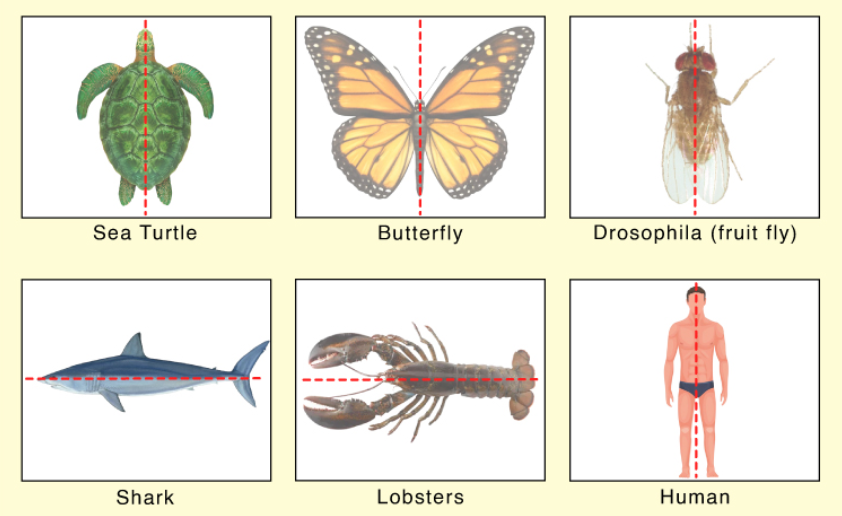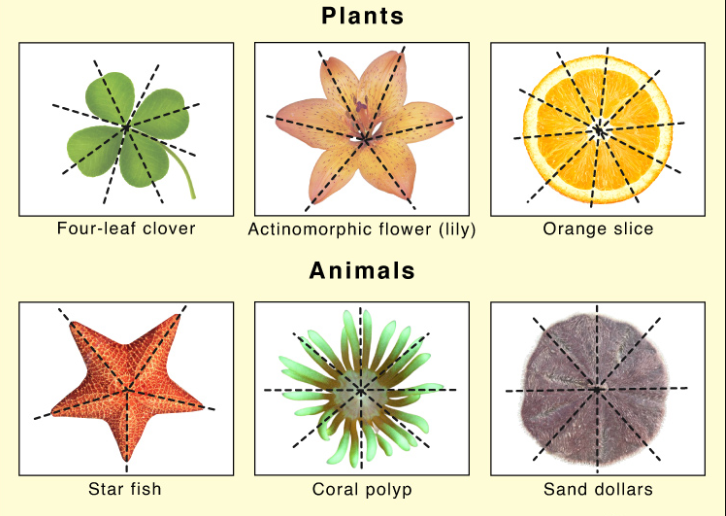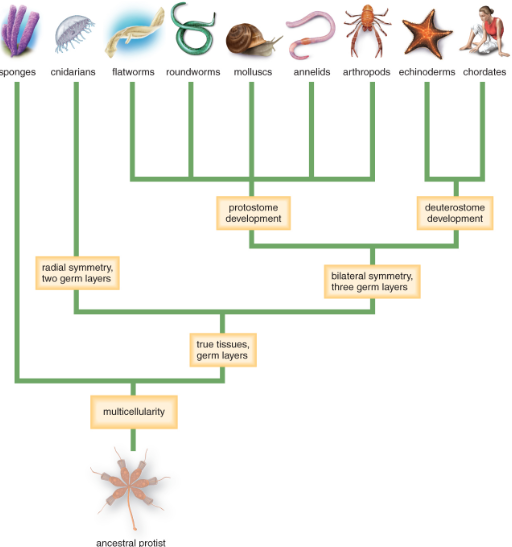Unit 3: Chp 3
5.0(1)
Card Sorting
1/54
Study Analytics
Name | Mastery | Learn | Test | Matching | Spaced |
|---|
No study sessions yet.
55 Terms
1
New cards
What is a *fungus?*
* eukaryotic organism
* vital heterotrophs
* vital heterotrophs
2
New cards
Why are *fungi important?*
* used in medicines, alcohol
* decompose dead organic matter
* recycling nutrients back into the ecosystem.
* decompose dead organic matter
* recycling nutrients back into the ecosystem.
3
New cards
What are the *differences* between **fungi and** __**plants**__
* Fungi are **heterotrophic** while plants are __**autotrophic**__
* Genetic sequence/expression (genotype/phenotype)
* Cell structure (plants __**have**__ chloroplasts while **fungi don’t**)
* Genetic sequence/expression (genotype/phenotype)
* Cell structure (plants __**have**__ chloroplasts while **fungi don’t**)
4
New cards
What are the *5 major phyla of Fungi*?
Chytridiomycota, zygomycota, glomeromycota, ascomycota, and basidiomycota
5
New cards
What are the key characteristics of *chytridiomycota/chrytids?*
* only swimming fungi
* are saphrotes (heterotrophs)
* be either single or multi-cellular
* are saphrotes (heterotrophs)
* be either single or multi-cellular
6
New cards
What are the key characteristics of *zygomycota/zygomycetes?*
* fruit/bread mould
* commercially used
* are insect parasites
* commercially used
* are insect parasites
7
New cards
What are the key characteristics of *glomeromycota/glomeromycetes?*
* decomposers
* forms symbiotic relationships w/ plant roots
* exchanges nutrients between said plants
* forms symbiotic relationships w/ plant roots
* exchanges nutrients between said plants
8
New cards
What are the key characteristics of *ascomycota/ascomycetes?*
* yeast, mould
* cause plant diseases
* cause plant diseases
9
New cards
What are the key characteristics of *basidiomycota/basidiomycetes?*
* mostly decomposers
* mushrooms, puffballs, and bracket fungi
* forms symbiotic relationships w/ plants
* mushrooms, puffballs, and bracket fungi
* forms symbiotic relationships w/ plants
10
New cards
What is *mycelium?*
It’s a root that *collects nutrients* from the environment to help fungi reproduce and forms the *general body* of a fungus
11
New cards
What is *hypha?*
It is the individual parts that *make up* the mycelium
12
New cards
What is the *chitin?*
It’s the chemical that makes up fungi cell walls
13
New cards
Explain the life cycle of a *basidiomycete* (mushroom decomposer)
It involves the formation of a fruiting body (e.g. mushroom) that produces basidiospores through sexual reproduction
14
New cards
What is a *symbiotic relationship?*
It’s a long-term interaction between organisms of two different species
15
New cards
What is a *lichen?*
It’s the relationship between **fungi and algae/photosynthetic plant:** found in harsh environments and monitors environmental health
16
New cards
What is a *mychorrhiza relationship?*
It’s relationship between **fungi and plant roots**: fungi provide nutrients to plants in exchange for vital nutrients between the two, important relationship
17
New cards
What are some examples of diseases caused by *fungi?*
* Ringworm
* Candida Albians (yeast infection)
* Aspergillus Fumigatus (infection anywhere)
* Candida Albians (yeast infection)
* Aspergillus Fumigatus (infection anywhere)
18
New cards
What are *plants*?
* eukaryotic organism
* autotrophs (photosynthesis)
* autotrophs (photosynthesis)
19
New cards
Why are *plants important?*
* regulate climate (consume CO2 and produce O2)
* maintain soil health
* used in medications
* maintain soil health
* used in medications
20
New cards
What are the 4 major groups of *plants?*
Bryophytes (moss), Lycophytes (ferns), Gymnosperms (conifers), and Angiosperms (flowering plants)
21
New cards
How did plants evolve from *charophytes (green algae)?*
Adaptations occurred such as:
* __cuticle (protects plant, retains water)__ to prevent drying out
* __stomata (small pores)__ for gas exchange
* development of vascular tissue to transport water and nutrients
* __cuticle (protects plant, retains water)__ to prevent drying out
* __stomata (small pores)__ for gas exchange
* development of vascular tissue to transport water and nutrients
22
New cards
What are the characteristics of *bryophytes?*
* e.g. **mosses, liverworts, hornworts**
* seedless plants that reproduce through spores
* found in damp habitats
* lack of vascular tissue
* seedless plants that reproduce through spores
* found in damp habitats
* lack of vascular tissue
23
New cards
What are the characteristics of *lycophytes and pterophytes?*
* e.g. **ferns, clubmosses, horsetails**
* seedless plants that reproduce through spores
* found in damp habitats
* has vascular tissue
* seedless plants that reproduce through spores
* found in damp habitats
* has vascular tissue
24
New cards
What are the characteristics of *gymnosperms?*
* e.g. **conifers (needle trees - spruce, fir, cedar)**
* flowerless plants that reproduce through seeds
* found in dry habitats (forests)
* has vascular tissue
* flowerless plants that reproduce through seeds
* found in dry habitats (forests)
* has vascular tissue
25
New cards
What are the characteristics of *angiosperms?*
* e.g. **flowers (can be flowered trees - shrub, grass, flower)**
* reproduce through seeds
* found in many many habitats
* has vascular tissue
* reproduce through seeds
* found in many many habitats
* has vascular tissue
26
New cards
What is the life cycle of *plants?*
* diploid stage = __**sporophyte**__, which produces haploid __**spores**__ through __**meiosis**__
* haploid stage = **gametophyte**, which produces haploid **gametes** through **mitosis**
* haploid stage = **gametophyte**, which produces haploid **gametes** through **mitosis**
27
New cards
What are *animals?*
* most complex organisms
* multi-cellular eukaryotes
* multi-cellular eukaryotes
28
New cards
Why are *animals important?*
* help us understand humans better
* provide resources and comfort (pets)
* provide resources and comfort (pets)
29
New cards
What is believed to be the *common ancestor* *for all animals?*
* lived approximately 800 million years ago
* small, flagellated, unicellular organism
* small, flagellated, unicellular organism
30
New cards
What is *bilateral symmetry?*
It’s the symmetry of animals that splits body parts along the midline with mirror images on either side (usually left and right)

31
New cards
What is *radial symmetry?*
It’s the symmetry of animals that splits body parts around a central point with multiple planes of symmetry

32
New cards
How can animals be *classified*?
\
* **embryonic development:** protostome (mouth first then anus - vertebrate rankings) and deuterostomes (anus then mouth - aquatic creatures)
* **spinal column:** vertebrate (has one) and invertebrate (doesn’t have one)
* **symmetry**: bilateral (left and right) and radial (around central point/axis)
* **embryonic development:** protostome (mouth first then anus - vertebrate rankings) and deuterostomes (anus then mouth - aquatic creatures)
* **spinal column:** vertebrate (has one) and invertebrate (doesn’t have one)
* **symmetry**: bilateral (left and right) and radial (around central point/axis)

33
New cards
What is a *protosome*?
An organism that develops a **mouth first** then the **anus**; every other animal - tiger, dog, rat
34
New cards
What is a *deuterosome?*
An organism that develops an **anus first** then the **mouth**; aquatic creatures - starfish, urchin
35
New cards
What is a *vertebrate*?
It’s an animal *with* a vertebral column/spine
36
New cards
What is an *invertebrate?*
It’s an animal *without* a vertebral column/spine
37
New cards
What are *germ layers?*
They’re layers of cells that become specialized tissues: *ectoderm (outer), mesoderm (middle), and endoderm (inner)*
38
New cards
What does the *ectoderm layer* do?
* outer-layer
* gives rise to the skin and nervous system
* some can produce shells, scales, feathers, or hair
* gives rise to the skin and nervous system
* some can produce shells, scales, feathers, or hair
39
New cards
What does the *endoderm layer* do?
* inner-layer
* forms lining of the gut
* for some organisms, their respiratory system
* forms lining of the gut
* for some organisms, their respiratory system
40
New cards
What does the *mesoderm layer* do?
* middle-layer
* gives rise to the circulatory, reproductive, excretory, and muscular systems
* gives rise to the circulatory, reproductive, excretory, and muscular systems
41
New cards
What is a *coelom?*
It’s a fluid filled body cavity that:
* separates the gut from the body wall
* provides space for internal organ growth
* grown from the *mesoderm layer*
* separates the gut from the body wall
* provides space for internal organ growth
* grown from the *mesoderm layer*
42
New cards
What are the *simplest invertebrates?*
Porifera and cnidaria
43
New cards
What are the key characteristics of *porifera?*
* look like coral
* immobile and range in size
* hermaphrodites (organisms with both male and female parts) pass through pores in the body wall
* immobile and range in size
* hermaphrodites (organisms with both male and female parts) pass through pores in the body wall
44
New cards
What are the key characteristics of *cnidaria?*
* look like jellyfish
* no mesoderm
* specialized nerve, muscle, digestive, and reproductive tissue
* skeletons made of calcium chloride
* no mesoderm
* specialized nerve, muscle, digestive, and reproductive tissue
* skeletons made of calcium chloride
45
New cards
What are the *6 phyla of invertebrates*?
Arthropoda, nematoda, annelida, mollusca, rotifera, platyhelminthes
46
New cards
What are the key characteristics of *arthropoda?*
* creatures with grabby arms - crab, scorpion, spider
* segmented bodies with joint appendages
* complex sensory system
* vital in both aquatic and terrestrial ecosystems
* segmented bodies with joint appendages
* complex sensory system
* vital in both aquatic and terrestrial ecosystems
47
New cards
What are the key characteristics of *nematoda?*
* parasitic worms
* unsegmented, completely digestive, bodies
* parasites
* unsegmented, completely digestive, bodies
* parasites
48
New cards
What are the key characteristics of *annelida?*
* regular worms - earthworm
* mostly segmented bodies and organs
* gas exchange through skin/gill
* bristles on the outer bodies for movement
* mostly aquatic
* mostly segmented bodies and organs
* gas exchange through skin/gill
* bristles on the outer bodies for movement
* mostly aquatic
49
New cards
What are the key characteristics of *mollusa?*
* snails
* three unsegmented sections: foot, mass (body), and mantle
* special radula (tongue) for scraping
* three unsegmented sections: foot, mass (body), and mantle
* special radula (tongue) for scraping
50
New cards
What are the key characteristics of *rotifera?*
* tiny aquatic ‘animals’ (smaller thna 2mm)
* live in fresh water
* no respiratory or circulatory system
* live in fresh water
* no respiratory or circulatory system
51
New cards
What are the key characteristics of *platy-helminthes?*
* flat, tiny (1-5mm), unsegmented on worms
* digestive cavity with only one opening
* no coelom
* digestive cavity with only one opening
* no coelom
52
New cards
What are the two *subgroups* off the *Deuterostomes?*
Echinoderms and chordates
53
New cards
What are the key characteristics of *echinoderms?*
* subgroup of deuterosomes
* no head (eyeless animals - starfish, urchin)
* no respiratory, circulatory, or excretoy system
* no head (eyeless animals - starfish, urchin)
* no respiratory, circulatory, or excretoy system
54
New cards
What are the key characteristics of *chordates?*
* subgroup of deuterosomes
* includes almost every animal
* success from the **development of**: notochord (enhance mobility), limbs, waterproof amniotic egg, large internal skeleton and vertebrate skeleton
* includes almost every animal
* success from the **development of**: notochord (enhance mobility), limbs, waterproof amniotic egg, large internal skeleton and vertebrate skeleton
55
New cards
What are the *7 major phyla of vertebrates*?
* **Agnathans** (jawless fishes - eels, lamprey)
* **Chondrichthyes** (cartilaginous fishes - predators: sharks, rays)
* **Actinopterygii** (bony fish - salmon, bass, tuna)
* **Amphibia** (cold-blooded - frog, salamander)
* **Reptilia** (cold - lizard, snake, turtle)
* **Aves** (birds - warm-blooded), M
* **Mammalia** (warm, humans, whales, bats)
* **Chondrichthyes** (cartilaginous fishes - predators: sharks, rays)
* **Actinopterygii** (bony fish - salmon, bass, tuna)
* **Amphibia** (cold-blooded - frog, salamander)
* **Reptilia** (cold - lizard, snake, turtle)
* **Aves** (birds - warm-blooded), M
* **Mammalia** (warm, humans, whales, bats)